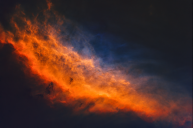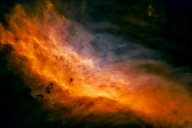Howdy, Stranger!
It looks like you're new here. If you want to get involved, click one of these buttons!
In this Discussion
An argument for stretching *before* combining?
I've viewed most of the narrowband processing examples in your courseware in Fundamentals as well as Horizons. I didn't see any cases where you used GHS to stretch the narrowband channels prior to using channel combination to create a color image. I've had a suspicion for about a year now, that it might actually be better to use the vastly superior capabilities of GHS to stretch each channel in order to squeeze out every last detail in each channel, since they are all different. But my skills have been mediocre at best, until I started your courseware about a month ago. Your narrowband techniques greatly improved my processing results, but I still could not shake the thought of stretching with GHS prior to combination.
So I went against all conventional wisdom and proceeded to do my best processing with the following workflow, starting with pristine data from WBPP (California nebula, which has really weak OIII, 8 hours per channel, 300sec subs):
LINEAR----------------------------
BXT - 30%
NXT - 50%
SXT
On starless images:
DBE - custom points in dark areas and corners, very little gradient was changed, not really needed (?)
BXT - 60%
Linear Fit - I thought about doing this, but what would be the point, considering next step?
GHS - Spent a lot of time stretching each individual channel in order to maximize detail and contrast in both faint and strong signal areas. Dark areas in each channel I tried to make approximately the same darkness.
NON-LINEAR ------------------------------
NBColorMapper - I very carefully selected the colors for each channel to more or less resemble what channel combination does with SHO input and narrowband normalization, as well and the other processing step listed in your narrowband workflow doc.
SelectiveColorCorrection - I played around with this process to get colors "better looking."
Played with other things likeLocalHistogramEqualiztion per your narrowband workflow doc.
As you can see in the following images, the one where I stretched each channel with GHS *before* combining, I was able to wrestle out of lot more of the faint detail, and the actual detail is much sharper. There was no need to even consider a green color removal (why even mess around with green channel in the first place??). I still don't feel I have much place making this argument for stretching before combining, but I can't deny that I got better results this way. There may be other factors of which I am not aware. I've tried this several times, with different endpoints, but it was always much easier to get the better results with the workflow above, especially in the dark dust areas in the nebula, as well as the overall sharpness.
I would like to hear your comments on this experiment. Have you tried it this way?
Thanks!!


Stretch after Combine.png
1626 x 1080 - 2M


Stretch before Combine.png
1618 x 1080 - 2M

Comments